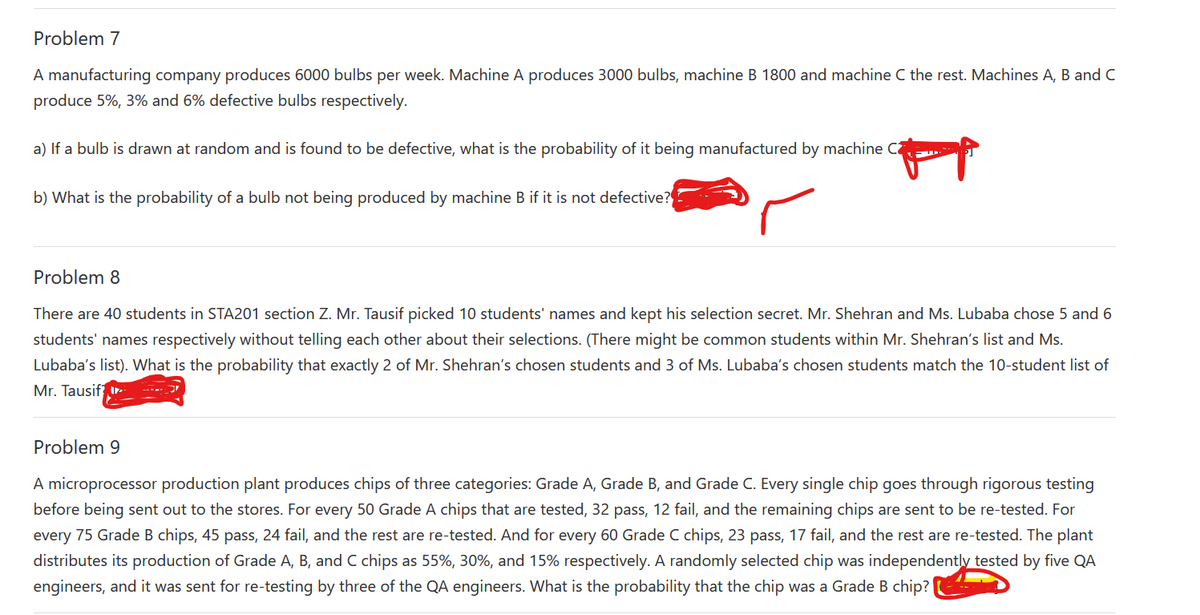Problem 7 A manufacturing company produces 6000 bulbs per week. Machine A produces 3000 bulbs, machine B 1800 and machine C the rest. Machines A, B and C produce 5%, 3% and 6% defective bulbs respectively. a) If a bulb is drawn at random and is found to be defective, what is the probability of it being manufactured by machine C b) What is the probability of a bulb not being produced by machine B if it is not defective? Problem 8 There are 40 students in STA201 section Z. Mr. Tausif picked 10 students' names and kept his selection secret. Mr. Shehran and Ms. Lubaba chose 5 and 6 students' names respectively without telling each other about their selections. (There might be common students within Mr. Shehran's list and Ms. Lubaba's list). What is the probability that exactly 2 of Mr. Shehran's chosen students and 3 of Ms. Lubaba's chosen students match the 10-student list of Mr. Tausif Problem 9 A microprocessor production plant produces chips of three categories: Grade A, Grade B, and Grade C. Every single chip goes through rigorous testing before being sent out to the stores. For every 50 Grade A chips that are tested, 32 pass, 12 fail, and the remaining chips are sent to be re-tested. For every 75 Grade B chips, 45 pass, 24 fail, and the rest are re-tested. And for every 60 Grade C chips, 23 pass, 17 fail, and the rest are re-tested. The plant distributes its production of Grade A, B, and C chips as 55%, 30%, and 15% respectively. A randomly selected chip was independently tested by five QA engineers, and it was sent for re-testing by three of the QA engineers. What is the probability that the chip was a Grade B chip?
Addition Rule of Probability
It simply refers to the likelihood of an event taking place whenever the occurrence of an event is uncertain. The probability of a single event can be calculated by dividing the number of successful trials of that event by the total number of trials.
Expected Value
When a large number of trials are performed for any random variable ‘X’, the predicted result is most likely the mean of all the outcomes for the random variable and it is known as expected value also known as expectation. The expected value, also known as the expectation, is denoted by: E(X).
Probability Distributions
Understanding probability is necessary to know the probability distributions. In statistics, probability is how the uncertainty of an event is measured. This event can be anything. The most common examples include tossing a coin, rolling a die, or choosing a card. Each of these events has multiple possibilities. Every such possibility is measured with the help of probability. To be more precise, the probability is used for calculating the occurrence of events that may or may not happen. Probability does not give sure results. Unless the probability of any event is 1, the different outcomes may or may not happen in real life, regardless of how less or how more their probability is.
Basic Probability
The simple definition of probability it is a chance of the occurrence of an event. It is defined in numerical form and the probability value is between 0 to 1. The probability value 0 indicates that there is no chance of that event occurring and the probability value 1 indicates that the event will occur. Sum of the probability value must be 1. The probability value is never a negative number. If it happens, then recheck the calculation.

Step by step
Solved in 2 steps




